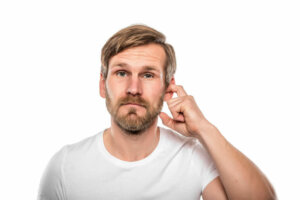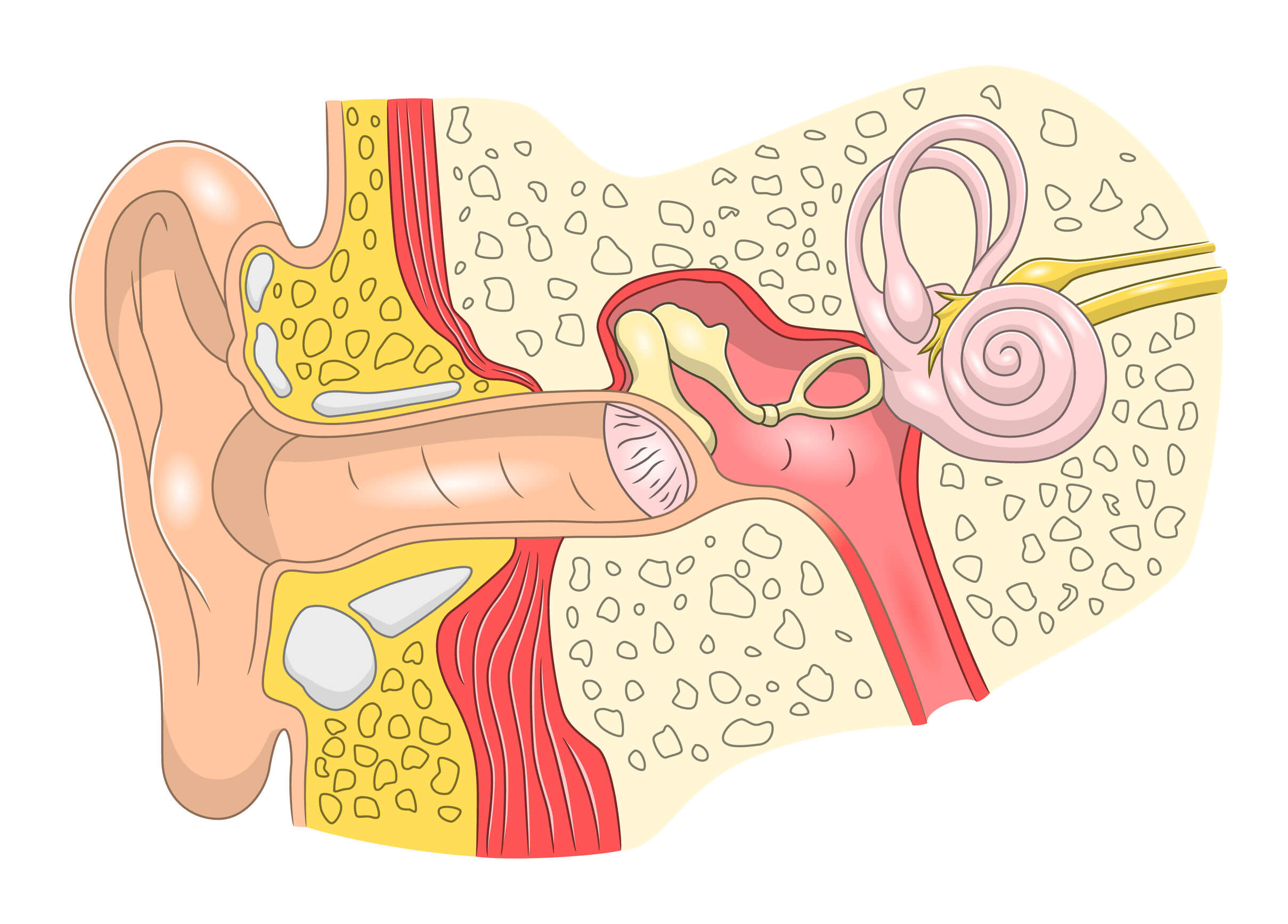How to Get Water Out of Your Ear

Water trapped inside the ear canal can be very unpleasant. It usually builds up after swimming, diving, or after taking a long bath. The pressure can make your ears feel like they’re about to burst, limit your hearing, and increase your risk of infection. We’ll teach you how to get the water out of your ear the right way.
Although water trapped in the ear drains on its own after a few minutes or hours, it can sometimes stay stagnant for longer. When this is the case, you run the risk of developing swimmer’s ear (external otitis). This is an infection due to the accumulation of bacteria caused by humidity. Let’s see what you can do to get the water out of your ear and avoid these problems.
6 ways to get water out of your ear
The first idea you may have to get the water out of your ear is to use cotton swabs. However, we must warn you that it’s not a recommended option, and it can even make the feeling worse. Doing so can push water and wax further in, making it difficult to remove or drain naturally.
This also encourages the entry of bacteria and damage to the eardrum in your quest to absorb the remaining water. We advise you not to use cotton swabs to remove the water from the ear. Instead, you can opt for the following.
1. Incline your head
The ear is designed in a millimetric way to prevent the passage of agents from outside. The ear canal itself facilitates drainage, although sometimes you need to help it a bit to speed up the process.
The first thing you can try is to dry the outer ear with a towel. Then, tilt your head towards your shoulder and stretch your lobe down with your hand. The incline will facilitate the transfer of the water from the inside to the outside by gravity, and by stretching the lobe, you’ll add a couple of degrees of inclination in your favor. This technique is the most effective for removing water from the ear.
2. Create a vacuum with your hand

Another quite practical method is to create a vacuum that works like a pump to drain the water. To do this, all you need is to use the palm of your hand and tilt your head a little. Reach out and press the palm directly over the outer ear. Make sure it’s right in the center of the palm.
Repetitively push in and out so that you feel like creating an airtight vacuum with the air inside. Flatten your hand when pressing and plump it up a bit when you take it outside. Don’t peel it off completely to break the vacuum. Repeat this movement together with your head bowed to drain the water in a minute or two.
3. Lie on your side in bed
If the above techniques haven’t worked, you can try a less conventional one: Lie on your side in bed and wait for gravity to allow the water to drain completely. This method works especially when water has collected in the deepest part of the ear canal.
To do this, put a towel on the bed and place your ear in the center of it. Wait 10-15 minutes and then dry the outer ear. If the feeling of pressure still persists, extend the waiting time by an additional 10-15 minutes. If you wish, you can complement it with the previous techniques.
4. Use a hair dryer
Using a hair dryer can be another practical way to get water out of the ear. It’ll allow you to accelerate the evaporation process, and thus eliminate the annoying sensation of pressure of the accumulated water. As it works best when it’s in the part of the external channel, we recommend that you apply some of the previous techniques to transfer the water from the interior.
Then, turn on the hair dryer and place it about 12 inches from the outer ear. Move it in several directions and bring it closer for a few seconds up to about 8 inches. Stretch the earlobe with your hand to allow the warm air to penetrate a little further into the cavity.
5. Use rubbing alcohol and vinegar

Does it make sense to add more liquid to an area where you intend to remove it? Yes, it does. Alcohol and vinegar can speed up the evaporation process, counteracting the growth of bacteria in the ear canal. It’s a homemade solution that replaces the special drops that you can buy in a pharmacy.
The solution is very simple: Mix one part alcohol and one part vinegar in a container. Then use a dropper or needleless syringe to pour 1 to 2 drops of the solution into your ear. Allow it to soak in for a few seconds, then apply any of the above methods to facilitate drainage.
6. Use special drops
Finally, and in case the previous methods haven’t been effective, you can also try special drops to unclog the ears. You can get them in the nearest pharmacy and they’re also useful for the extraction of ear wax.
It’s very important that you read the indications of the product before using it. The dose and the mode of use vary with each manufacturer, as well as the environmental conditions where its application is allowed (in very cold conditions they can be counterproductive). Most are antiseptics and pain relievers.
If none of the techniques listed are effective for you, the water will drain naturally within a couple of hours to a day or two. If it’s delayed for a longer time and is also accompanied by itching, peeling, earache, and discharge, don’t hesitate to consult a specialist. You may be facing an infection that requires timely treatment.
Water trapped inside the ear canal can be very unpleasant. It usually builds up after swimming, diving, or after taking a long bath. The pressure can make your ears feel like they’re about to burst, limit your hearing, and increase your risk of infection. We’ll teach you how to get the water out of your ear the right way.
Although water trapped in the ear drains on its own after a few minutes or hours, it can sometimes stay stagnant for longer. When this is the case, you run the risk of developing swimmer’s ear (external otitis). This is an infection due to the accumulation of bacteria caused by humidity. Let’s see what you can do to get the water out of your ear and avoid these problems.
6 ways to get water out of your ear
The first idea you may have to get the water out of your ear is to use cotton swabs. However, we must warn you that it’s not a recommended option, and it can even make the feeling worse. Doing so can push water and wax further in, making it difficult to remove or drain naturally.
This also encourages the entry of bacteria and damage to the eardrum in your quest to absorb the remaining water. We advise you not to use cotton swabs to remove the water from the ear. Instead, you can opt for the following.
1. Incline your head
The ear is designed in a millimetric way to prevent the passage of agents from outside. The ear canal itself facilitates drainage, although sometimes you need to help it a bit to speed up the process.
The first thing you can try is to dry the outer ear with a towel. Then, tilt your head towards your shoulder and stretch your lobe down with your hand. The incline will facilitate the transfer of the water from the inside to the outside by gravity, and by stretching the lobe, you’ll add a couple of degrees of inclination in your favor. This technique is the most effective for removing water from the ear.
2. Create a vacuum with your hand

Another quite practical method is to create a vacuum that works like a pump to drain the water. To do this, all you need is to use the palm of your hand and tilt your head a little. Reach out and press the palm directly over the outer ear. Make sure it’s right in the center of the palm.
Repetitively push in and out so that you feel like creating an airtight vacuum with the air inside. Flatten your hand when pressing and plump it up a bit when you take it outside. Don’t peel it off completely to break the vacuum. Repeat this movement together with your head bowed to drain the water in a minute or two.
3. Lie on your side in bed
If the above techniques haven’t worked, you can try a less conventional one: Lie on your side in bed and wait for gravity to allow the water to drain completely. This method works especially when water has collected in the deepest part of the ear canal.
To do this, put a towel on the bed and place your ear in the center of it. Wait 10-15 minutes and then dry the outer ear. If the feeling of pressure still persists, extend the waiting time by an additional 10-15 minutes. If you wish, you can complement it with the previous techniques.
4. Use a hair dryer
Using a hair dryer can be another practical way to get water out of the ear. It’ll allow you to accelerate the evaporation process, and thus eliminate the annoying sensation of pressure of the accumulated water. As it works best when it’s in the part of the external channel, we recommend that you apply some of the previous techniques to transfer the water from the interior.
Then, turn on the hair dryer and place it about 12 inches from the outer ear. Move it in several directions and bring it closer for a few seconds up to about 8 inches. Stretch the earlobe with your hand to allow the warm air to penetrate a little further into the cavity.
5. Use rubbing alcohol and vinegar

Does it make sense to add more liquid to an area where you intend to remove it? Yes, it does. Alcohol and vinegar can speed up the evaporation process, counteracting the growth of bacteria in the ear canal. It’s a homemade solution that replaces the special drops that you can buy in a pharmacy.
The solution is very simple: Mix one part alcohol and one part vinegar in a container. Then use a dropper or needleless syringe to pour 1 to 2 drops of the solution into your ear. Allow it to soak in for a few seconds, then apply any of the above methods to facilitate drainage.
6. Use special drops
Finally, and in case the previous methods haven’t been effective, you can also try special drops to unclog the ears. You can get them in the nearest pharmacy and they’re also useful for the extraction of ear wax.
It’s very important that you read the indications of the product before using it. The dose and the mode of use vary with each manufacturer, as well as the environmental conditions where its application is allowed (in very cold conditions they can be counterproductive). Most are antiseptics and pain relievers.
If none of the techniques listed are effective for you, the water will drain naturally within a couple of hours to a day or two. If it’s delayed for a longer time and is also accompanied by itching, peeling, earache, and discharge, don’t hesitate to consult a specialist. You may be facing an infection that requires timely treatment.
- Miyamoto R. Perforación del tímpano. Manual MSD. Disponible en: https://www.msdmanuals.com/es-ve/hogar/trastornos-otorrinolaringol%C3%B3gicos/trastornos-del-o%C3%ADdo-medio/perforaci%C3%B3n-del-t%C3%ADmpano
Este texto se ofrece únicamente con propósitos informativos y no reemplaza la consulta con un profesional. Ante dudas, consulta a tu especialista.







